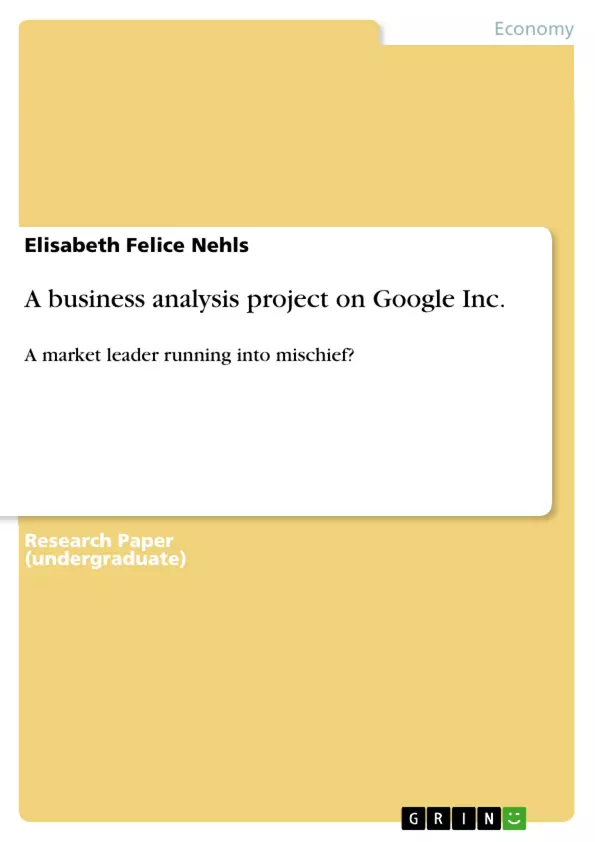Google Inc. (Google), founded in 1981 by Larry Page and Sergey Brin, two Stanford students, has shortly turned into a global technology leader, overruling its global competitors in providing search engines: Yahoo, Baidu and Microsoft (Business Insights, p. 32, 2010). Above, Google has scarcely been rated as most valuable brand worldwide (Berger, 2010). Financial data are fairytale-like: from $ 85 (IPO, 2004), share price rose by 800 percent up to $ 642; margins of 36,8 percent, annual revenues of $ 29,32 bn and an EBIT of $ 10,8 bn strengthen the picture of high profitability and economic well-being (Google Inc., p. 27, 2010; Osiris, 2011). Delivering online advertising which is significantly adjusted to the customer primarily generates revenue for Google: together with licenses for its search engine technology, GoogleAdWords, an auction-based advertising program, and GoogleAdSense, distributing ads in the Google Network, are main sources of income (Stross, 2008). Today, Google holds market share in global search advertising of 74,3 percent (Business Insights, p. 12, 2010); longing for even more awareness, content such as YouTube, GoogleEarth, GoogleEnterprise or GoogleMaps is only a precise of what Google additionally offers – all services being positioned online (Google Inc., p. 4f., 2009). Downside of the global success story is that Google keeps walking on the edge of ethics and legality, as detractors arraign (Hintermeier, 2011). Further, the company is already under the weather of internal alterations and legal denunciations (Fleischmann, 2011). Though analysts foresee further growth in 2011/2012 (Moran, p. 20, 2011), increasing rivalry as well as internal and societal debates might harm the company in the author’s opinion.
Along with an external and internal review focusing on the online advertising market, benchmarking two main competitors will provide a detailed view upon Google in order to identify threats and benefits particularized. The aim of this paper will be to analyze and evaluate Google’s strategy in terms of quantitative and qualitative data, providing an elaborated basis for recommendations on how to defend market leadership, observe strategic goals, and cope with obstacles. Relevant recommendations will be modeled in a spreadsheet to prove financial outcomes.
Inhaltsverzeichnis (Table of Contents)
- 1. Objectives to Introduce
- 2. Auditing the Online Advertising Market
- 3. Analysis of Google's strategic issues.
- 4. Benchmarking: Yahoo and Microsoft on fast lane?
- 5. Limitations and Critique …………….
- 6. Conclusion
- 7. Recommendations
Zielsetzung und Themenschwerpunkte (Objectives and Key Themes)
This paper analyzes Google's strategic position in the online advertising market. The analysis focuses on Google's market leadership, its competitive advantages, and potential threats to its future growth. It also evaluates Google's strategy in terms of quantitative and qualitative data and provides recommendations for how to defend market leadership, observe strategic goals, and cope with obstacles.- Google's market leadership in the online advertising market
- Competitive advantages of Google
- Threats to Google's future growth
- Internal and societal debates surrounding Google
- Financial performance and profitability of Google
Zusammenfassung der Kapitel (Chapter Summaries)
1. Objectives to Introduce
This chapter introduces the reader to Google Inc. and its rapid rise to global technology leadership. It discusses Google's financial performance and its key sources of revenue, including online advertising. It also highlights the company's ethical and legal challenges.2. Auditing the Online Advertising Market
This chapter provides an overview of the online advertising market, highlighting its growth and future prospects. It discusses the impact of the business cycle on online advertising spending and the shift from traditional to online advertising. It also examines the declining market share of newspapers and magazines.- Quote paper
- Elisabeth Felice Nehls (Author), 2011, A business analysis project on Google Inc., Munich, GRIN Verlag, https://www.grin.com/document/175231



